Castles of the Czech Republic: Castle Hluboka (part three)
Any castle is ... an “artificial cave” for more or less civilized people, since the uncivilized lived in natural caves. But any house is, first of all, people living in it. These are their characters, their actions, their story. For example, I always notice the balconies in the houses in the Czech Republic, as well as in Poland, in Spain, in the south of France and even in Cyprus and in ours. We have a balcony in 80% of cases, the warehouse of the old junk, which for some reason must be saved. There is a place where flowers are planted in boxes and where in the “worst case” there is a light table on openwork legs and the same two chairs. Or a fence near a private residential building. There is a fence! We again have a warehouse of old, often already rotten boards, some boxes, and God knows what else. Why and why? Is it really “expensive as a memory” and laid according to the principle “in the household and the rope will fit”? But what can this "rotten" and "crooked"? However, we must pay tribute to our balcony owners. Recently, we have more and more empty balconies, as well as those on which flowers grow. Perhaps this is from the growing general impoverishment ...
However, this is nothing more than "thinking at the main entrance," inspired by what he saw. Perhaps more important, it seems to me, it is necessary to emphasize in any case the role of His Majesty the Case. Examples of the role played by the case in our lives, "a million and a small truck", and, by the way, the same castle Hluboka nad Vltavoy is another confirmation of this. After all, he could not get to the Schwarzenberg family. Because the son of Prince Adam Schwarzenberg, who bought it from the descendants of Don Marradas in 1661, was born second and, according to family tradition, had to be ordained in knightly times. Moreover, he studied at the Royal Academy in Paris, where he communicated with Cardinal de Richelieu himself and was even accepted by his personal request in 1635 in the Order of Johannite. And then his older brother suddenly dies, and Jan-Adolf I refuses the dignity prepared for him and goes to serve at the court of the emperor. In 1650, he was awarded the Order of the "Golden Fleece", in 1670, he became an imperial earl, the following year he was given the privilege to mint his own coins and even the right to produce people of low origin to a noble title. Distinguished by his economic abilities, he looked out for Hluboka Castle and managed to buy it fairly cheaply, but if it had not happened all this, his older brother could not have bought it and today he would belong to a different genus, and he could have looked completely different!
People at the castle is always a lot. Even in the early morning.
On the other hand, Fate is merciless to noblemen in the same way as to the last of the poor. What is also seen in the Schwarzenberg family. For example, when one of the representatives of this clan Adam-Franz accompanied the emperor Charles VI in 1732 during his journey through the Czech Republic, and one of the hunts became fatal for him. With an unfortunate shot, he was killed, and his wife, Princess Eleanor-Amalia, who amazed the entire Vienna court with her beauty, then locked herself in her estate, focusing all her attention on raising her son.
The marriage of Prince Joseph Schwarzenberg with the Belgian Princess Paulina was also quite happy. After the wedding in 1794, and before 1810, she bore him nine children (and she gave birth ten times, one child died during childbirth!) And was very proud of her pregnancies, followed field work, kept housekeeping, but also found time to paint and even published two notebooks of her etchings with views of Czech landscapes in 1806 -1809.
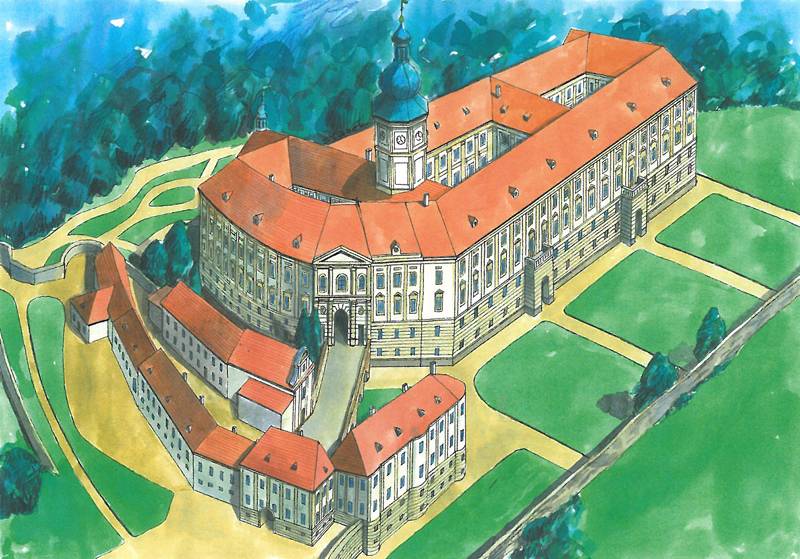
Reconstruction of the appearance of the castle Hluboka in the Baroque style.
And when 1 July, 1810, Princess Paulina with her husband and two daughters attended a ball at the Austrian embassy in Paris on the occasion of the marriage of Emperor Napoleon with the Habsburg Duchess Maria-Louise in a wooden pavilion specially built for him, covered with beautiful draperies, she was worn out of the way, and she was wed by the rest of the party. .
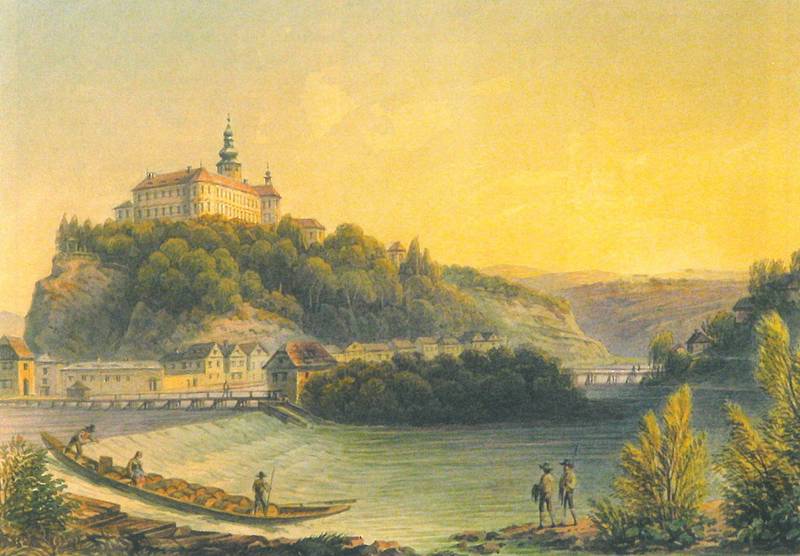
View of the castle before its restructuring. Watercolor by J. Gerstmeyer 1832.
Princess Paulina and her daughter Eleonora together with the imperial couple were among the first to be brought out. But not seeing her second daughter, she rushed after her into the burning room ... They only found her the next day and only identified her by her jewels. Moreover, her second daughter was saved, although she received severe burns to her back. On examination of the body, it turned out that the princess was in the second month of pregnancy, so it is rightly said that "the rich also cry."
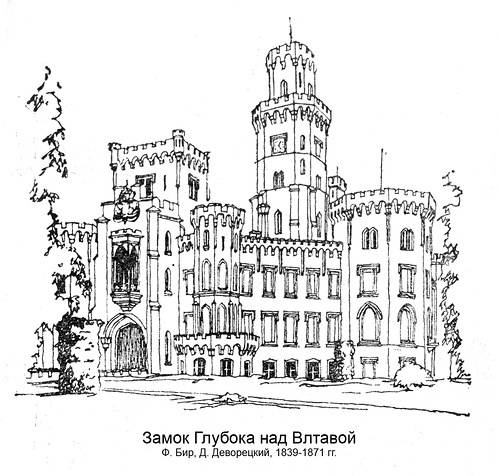
And here he appears already rebuilt and in the schedule.
But the future builder of Hluboka Castle, Jan-Adolf II, when he traveled to England on behalf of the emperor, was engaged not only in dancing at balls and admiring English castles, but also studied the British method of processing iron, visited the Stonbridge steel factory, was interested in new steam and textile machines. Upon his return, he not only started rebuilding his castle, but also built an English project on his estate in Turrach ... a blast furnace, which in 1841, began to produce iron and steel four times more than the old one.
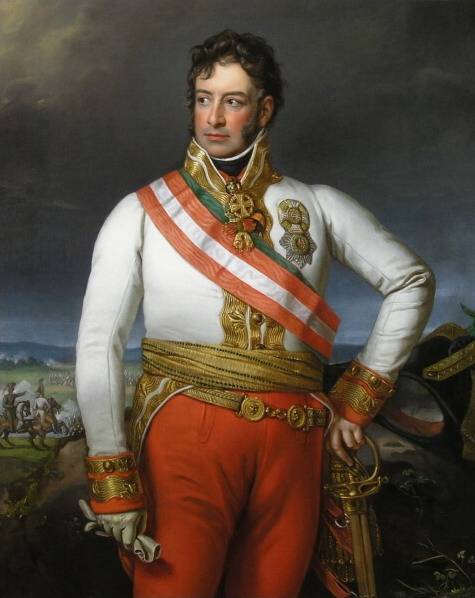
Karl Philipp Schwarzenberg, Field Marshal, commanding the Allied forces in the “Battle of the Nations” at Leipzig.
He also began planting rapeseed and sugar beet on his lands, which made it possible to establish the first princely sugar factory in 1852. He also ordered to bring the first land reclamation machines from England, and again, following the English model, improved the dairy production. Schwarzenberg cheeses began to win at agricultural exhibitions, breweries brewed excellent beer, the new chemical laboratory in Lovositsy analyzed the soil and the products themselves, which further helped to improve their quality, popularity and ... income. The attitude to forestry and pond farming was radically changed. So in the end, nothing remained on the estate of Schwarzenbergen from the old feudal economy.
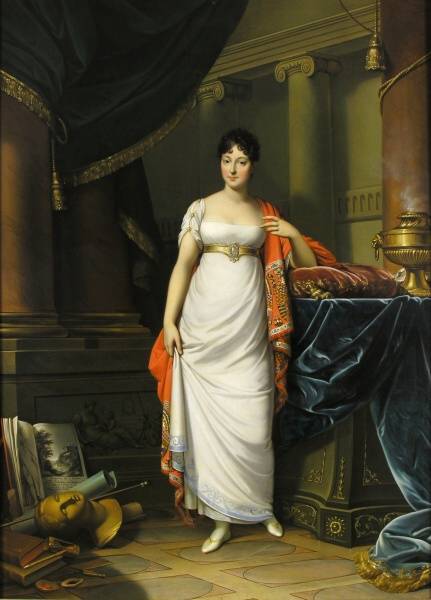
And this is the same unfortunate Paulina, burned by the artist Jan Lumpy, which was painted after her death, as hinted at the drawing supplies scattered at her feet and the fallen bust.
Well, and his wife - Eleonora, a princess from Liechtenstein (1812 - 1873), the marriage with which he took place in 1830 in Vienna, a blonde with transparent delicate skin, was a very talented and charming creature. More than 20 for years, she then set the tone at court, and at balls, and at all celebrations, she was always in the center of attention of Viennese society. Like many representatives of the nobility of the time, she painted beautifully. Her teacher was court painter Ferdinand Ruck Schwarzenberg. The princess is not enough to write watercolors, she also mastered the technique of etching and began to depict their landscapes on plates, and then she painted them herself. When the reconstruction of the castle began, she literally penetrated into all its details: how to put upholstery on the walls, how to choose a parquet flooring pattern, gave instructions on the alteration of antique furniture, interior design, even the marking of park alleys - and that is her merit. But was she happy in marriage?
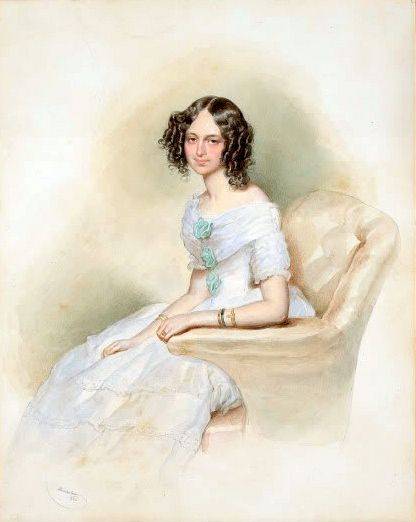
Portrait of Eleonora Schwarzenberg. Artist Josef Krihuber. Watercolor. 1842 year.
Most likely ... not very. For her husband, she gave birth to three children, and her older son Walter was somehow brought up separately from his mother and did not even live to be two years old: in some strange way he fell out of his baby carriage and so unfortunate that ... he died to death. It is not clear why he is absent from the Schwarzenberg family tree. For what to the unfortunate little one such disfavour was shown? Most likely it was her illegitimate child, and that's how it could happen to her, we will never know. However, as we said in Russia - “Foolish business is not cunning” ...
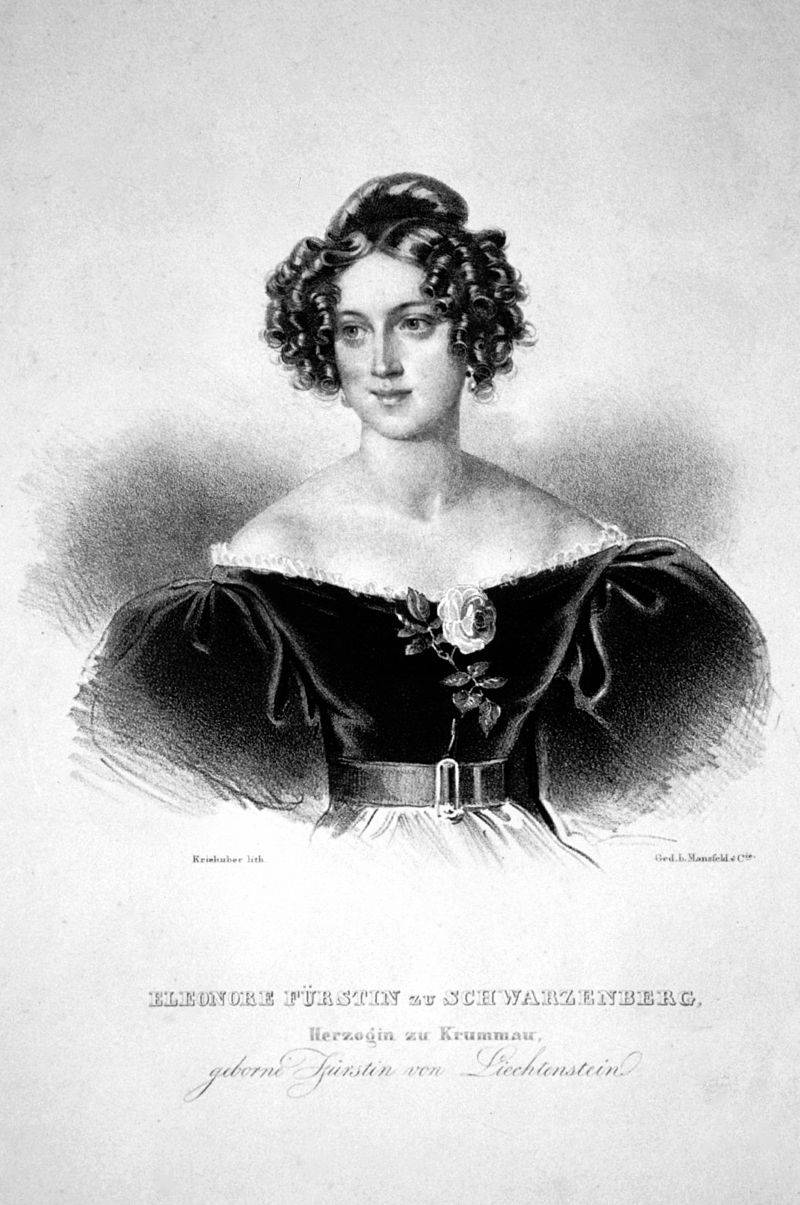
Another portrait of Princess Eleonora by the artist Josef Krihuber.
All, however, note that the princess was a strong woman, resolute and ... resourceful, and few men like these next to him. For example, once the famous Viennese portrait painter Hans Makar, who painted her portrait directly to the castle, was so carried away by the work (or princess) that he forgot about the intended audience with the emperor and missed the regular train to Vienna. But the princess took advantage of the telegraph in the house and ordered a special train for him, which delivered the artist to Vienna on time. Naturally, this required money and not small ones, and the princess’s husband hardly reacted to this spending with enthusiasm. After all, he was not interested in either the "novelties from Paris", which Eleanor wrote out, or the collection of paintings and tapestries. Therefore, according to the memories that have come down to us, quarrels often occurred in the house, and they usually happened every time she wanted to buy or buy some new novelty. Well, she also died not “just like that,” but after a serious illness in 1873, she didn’t see the end of the restructuring of her favorite castle. Jan Adolph II survived her for 15 years, saw the results of his and her labors and died quietly here. True, his son got not only the castle and the enterprises flourishing with him, but also huge debts.
It is known that learning is light, not learning is darkness. And as for the children of the castle owners, they understood it very well and tried to give their children a very good education. For example, in the castle next to the children's rooms, in addition to the babysitting room, there was also a study room, where a specially hired teacher was engaged in teaching children. In particular, with small Jan-Adolph II, German-speaking Emerich-Thomas Gogler was engaged in, who aroused interest in agriculture and forestry in the boy. And after all, he carried him through his entire adult life, he did not become either a weigh-in, a womanizer or a moto. It was not for nothing that when he traveled around England, he wrote down in a diary information about the device of kennels, the size of parks, the age of trees and new agricultural machines. His son Adolf-Josef went his father's way and became, one might say, hereditary entrepreneur. He built a new Schwarzenberg brewery, and the old distillery modernized. He also collected natural formations and minerals, and as an amateur archaeologist he conducted archaeological excavations, studying the prehistoric monuments of the Czech Republic.
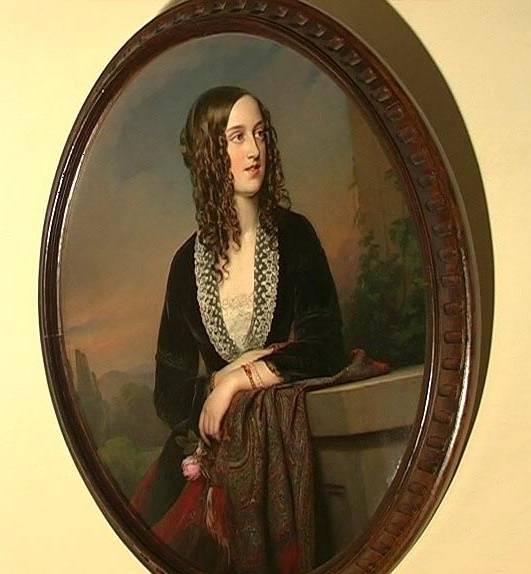
And another portrait of Eleanor from the castle of Hluboka by the artist Shrotsberg.
However, not only the gentlemen themselves studied. In the 19th century, support for public education became a tradition of the Schwarzenberg family. The family participated in the creation of the National Museum, supported artists, various schools, and ladies, in addition, also charity. Representatives of culture were invited to the castle, concerts were held, and schools and houses for orphans were taken under guardianship. Sometimes this kind of stock looked pretty funny. For example, in 1931, Princess Hilda became the “godmother” of a new fire hydrant, which the prince couple bought for a team of volunteer firefighters in Gordeyovitsy. In winter, from December to Easter, schoolchildren from poor families were cooked with nutritious soup at the expense of the family. Total for the period 1938-1939. Children received 9087 servings and 280 adults.
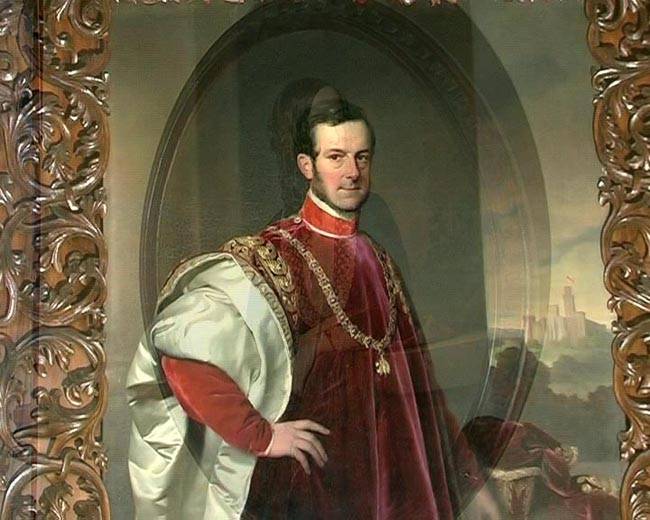
The wife of Princess Eleanor, Jan-Adolph II, in the ceremonial attire of a gentleman of the Golden Fleece of the artist Franz Shrotsberg. In the open window on the right, the artist depicted a flag completed by perestroika and a flag flying over its main tower - a sign that the sovereign prince is in the castle.
Well, the last of the owners of the castle, Dr. Adolph and his wife Hilda, were engaged in hunting and research expeditions to Africa. In 1931, they brought from the Congo a large collection of beetles, butterflies and other insects, which they donated to the National Museum in Prague. In 1933, they bought a plot of land of 1500 hectares near Nairobi, where in subsequent years they spent most of the winter. Shortly before the outbreak of World War II, they left the country and never returned to it, and died in a foreign land.
As you can see, a great wealth of happiness does not guarantee, but can help both its people and their country. You probably shouldn't give them the last shirt, nobody will appreciate it anyway, but to support talented young people, to patronize science and the arts, and the same African beetles to collect and send them to collections in museums of their native country is probably quite well-off people feasible.
To be continued ...
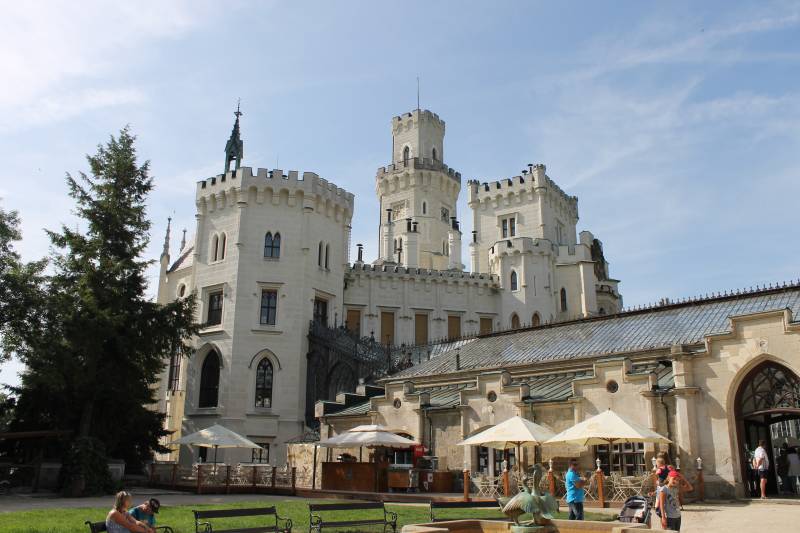
Information